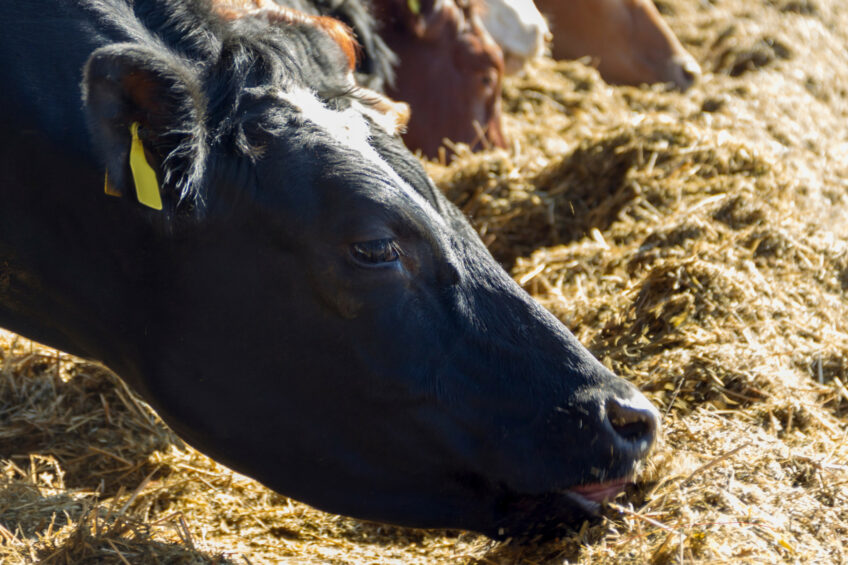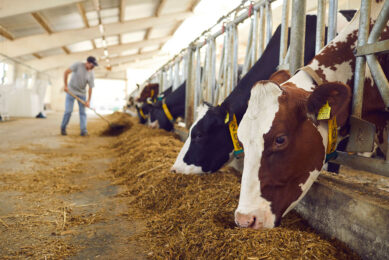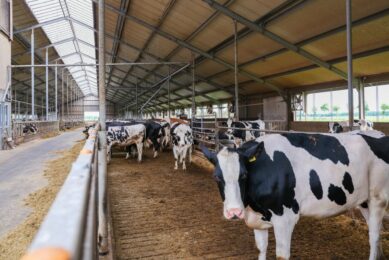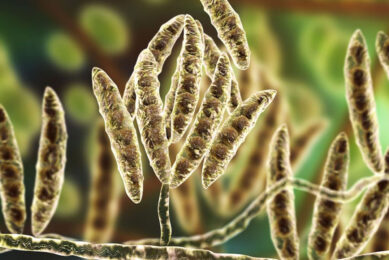Understanding rumen microbiota changes from prepartum to postpartum

During the transition period, dairy cows experience metabolic and physiological alterations in their rumen microbiota. Adverse conditions during this transition period impact rumen microbial composition, host digestion and metabolism, and thereby production performance. It is therefore important to understand the intrinsic links between rumen microbiota and host production traits for successful transition from prepartum to postpartum.
A dairy cow’s rumen is a complex microbial ecosystem that degrades cellulose and hemicellulose plant fibres to produce volatile fatty acids. These are absorbed and transported to the circulatory system to maintain metabolism, muscle development, and milk production.
Rumen microbiota, including bacteria, protozoa, and fungi, maintain a dynamic balance with the host and support health, production efficiency, and food safety in dairy cows. Bacteroidetes, Firmicutes, and Proteobacteria are relatively abundant in the rumen. Archaea domain microorganisms, some of which are methanogenic, are also found in the rumen but in a much lower abundance.
Alteration in rumen microbiota
Negative energy balance occurs from 3 weeks pre-calving to 3 weeks post-calving. This makes dairy cows more susceptible to metabolic disorders and immunological challenges. Various nutritional strategies and changes to rumen microbiota structure facilitate the switch from pregnancy to lactation. Feeding corn silage, grass silage, and spring barley decreases the abundance and diversity of rumen microbiota species such as Bacteroidetes from prepartum to postpartum.
On the other hand, the relative abundance of Prevotellaceae increases in postpartum rumen fluid in cows fed a high-concentrate diet during the early stage of lactation which is beneficial for postpartum cows. Prevotellaceae plays an important role in degrading polysaccharides and proteins and in fermenting starch, providing the energy source which highly prolific cows require.
Firmicutes abundance, which is associated with fibre digestion, decreases in the postpartum rumen fluid of dairy cows. Proteobacteria abundance increases throughout the transition period in cows that are fed a starch-based diet. The relative abundance of rumen Archaea decreases from the prepartum to the postpartum period when cows are fed high-grain rations, resulting in relatively lower methane production.
Impact of ketosis
During the transition period, long-term negative energy balance leads to ketosis, reduced reproductivity, poor lactation performance and welfare, resulting in great economic loss. Ketosis affects the metabolite profiles of the rumen, and creates high concentrations of butyric acid, sucrose, beta-hydroxybutyrate acid, and valerate, and low concentrations of glucose and propionate. In addition, ketosis alters rumen microbiota composition and affects rumen function.
Research studies have shown that ketosis leads to an increase in the relative abundance of Streptococcus bovis and a decrease in the relative abundance of Megasphaera elsdenii and Selenomonas ruminantium. Megasphaera elsdenii and Selenomonas ruminantium utilise carbohydrates or lactic acid to produce propionate – reducing their abundance worsens the negative energy balance in the transition period. In addition, cows with subclinical ketosis show an increase in the abundance of rumen microbiota including Bacteroidota, Christensenellaceae, Ruminococcus, and Thermomonas, and a reduction in rumen Prevotella abundance.
Impact on production traits
Rumen microbiota affects some production traits. For example, the ratio of Firmicutes to Bacteroidetes has a positive relationship with milk fat percentage. An increase in relative abundance of Lachnospiraceae and Firmicutes is associated with a reduction in milk fat yield. On the contrary, an increase in the relative abundance of Prevotella is related to a higher milk fat yield. An increase in the Succinivibrionaceae population is linked to improved feed efficiency and regulates milk production.
Catabacteriaceae, Methanobrevibacter, Ruminococcus, Streptococcus and Deltaproteobacteria have strong negative correlations with average milk production. Actinobacteria and Erysipelotrichaceae are positively correlated with milk production. Furthermore, an increase in Clostridium, Lachnospiraceae, and Erysipelotrichaceae population is associated with an increased milk protein percentage.

Regulating rumen microbiota
In modern dairy production systems, cows are fed high-fibre diets prepartum and high-concentrate diets postpartum. Therefore, rumen microbiota must adapt to the change in diet to maintain rumen function and production performance.
Various nutritional strategies can be applied to improve the rumen microbiota composition:
 Live yeast culture and yeast-based products
Live yeast culture and yeast-based products
Live yeast culture and yeast-based products activate rumen fibre-degrading bacteria such as Fibrobacter and Ruminococcus and lactate-using bacteria such as Megasphaera and Selenomonas; thus, improving fibre digestibility, milk quality, and production efficiency. In addition, administering yeast culture products as dietary supplements promotes the growth of rumen cellulolytic bacterial populations and regulates rumen function. Moreover, adding yeast culture and its products to dairy cow diets stabilises rumen pH, thus preventing the occurrence of ruminal ketosis and acidosis.
 Methyl donors
Methyl donors
Methyl donors including methionine improve production performance, immunometabolism, and liver function. Adding methionine to the diet of mid-lactation cows increases the abundance of Saccharofermentan, Acetobacter and Lachnospiraceae, which contribute to improved milk fat content. In addition, supplementing calcium salt of the hydroxy analog of methionine increases Prevotella, Streptococcus, and Desulfovibrio abundance in the rumen, which are associated with improved dry matter digestibility and microbial protein concentration.
 Essential oils
Essential oils
Essential oils interact with rumen microbial cell membranes and reduce methane emission. In addition, essential oils including clove, eucalyptus, garlic, oregano, and peppermint oils decrease the relative abundance of methanogenic archaeal bacteria. In contrast, high doses of essential oils may reduce the cellulolytic bacteria population and adversely impact apparent digestibility of dry matter.
Future perspectives
Heritable rumen microbiota is more related to dairy cow production traits compared to non-heritable microbiota. Future studies should therefore focus on changes in heritable rumen microbiota during transition period. In addition, further studies are required to explore the contribution rumen microbiota to production traits under different feeding conditions. Furthermore, genetic, environmental, and microbial interactions should be evaluated to better explain the differences observed in production performance.
Conclusion
Rumen microbiota composition and abundance undergoes dramatic changes during the shift from prepartum to postpartum. This alteration is characterised by reduction in some fibre-utilising bacteria and their partial replacement by soluble carbohydrate-utilising bacteria which impacts health, welfare, and production performance of dairy cows. Understanding the changes in rumen microbiota from prepartum to postpartum period optimises the postpartum production performance of dairy cows.










